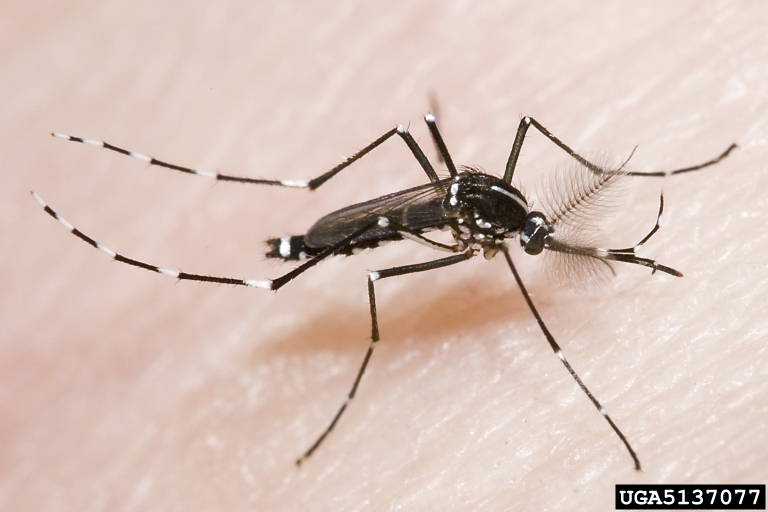
by Mark Tancig | Jul 29, 2021
Now that we’re getting plenty of rain and the temperatures are nice and toasty, our nemesis to enjoying the outdoors is back in full force. Yes, I’m talking mosquitoes, the reason for inventing window screens! If you’re gardening outside these days, you’ve probably been annoyed by one of the many mosquito species that occur in our area. Many of these mosquitoes are native species that play an important role in the food chain, feeding many aquatic and terrestrial wildlife, but some of them, like the daytime biting Asian tiger mosquito, are invasive species that were accidentally introduced. While mosquitoes are an important food source to more charismatic critters, they are annoying and can spread disease, and so we can benefit by reducing their presence.
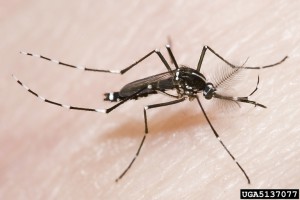
The Asian tiger mosquito, another annoying invasive species. Photo credit: Susan Ellis, Bugwood.org.
In addition to the age-old advice of draining any standing water, there are other control methods that can be very effective at reducing the mosquito population. One of the most effective and least-toxic options is the use of Bti products. These products come in granular or “donut” forms with the smaller granules being best for various uses around the home and the dunks/donuts for larger areas of standing water like ponds. These Bti products are considered a type of biological control since it is a species of bacteria, Bacillus thuringiensis israelensis to be precise, that causes mosquito, blackfly, and fungus gnat larvae to perish as they wiggle around and grow into their pupal stage. Because it only affects a narrow range of species, it is considered a selective pesticide that does not cause harm to non-target species, such as bees, birds, butterflies, frogs, lizards, and other desirable garden visitors. Bti can be sprinkled into rain barrels, bird baths, bromeliads, gutters, and other places where water may stand more than 5-7 days, the amount of time needed for mosquito eggs to develop into adults.
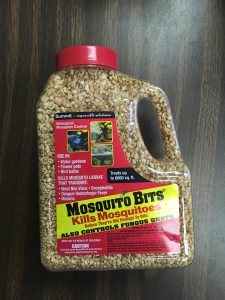
Bti granules prevent mosquito larvae from becoming biting adults. Photo by: Mark Tancig, UF/IFAS.
If considering other methods of mosquito control, such as the use of foggers, keep in mind that many of the pesticides used to control adult mosquitoes are not selective products and can kill the pollinators you may be trying to invite to your garden. Additionally, planting citronella plants, eating copious amounts of garlic, wearing repellent bracelets, or using ultra-sonic devices or cell phone apps has not been shown to repel mosquitoes so stick to what is known to work.
For a more enjoyable mosquito season, keep the window screens tight, wear long pants and sleeves and use appropriate repellents when outdoors, and do your best to minimize standing areas of water. If you have questions about mosquitoes and their control, visit the UF/IFAS Florida Medical Entomology Lab website (https://fmel.ifas.ufl.edu/) and browse the many resources available.
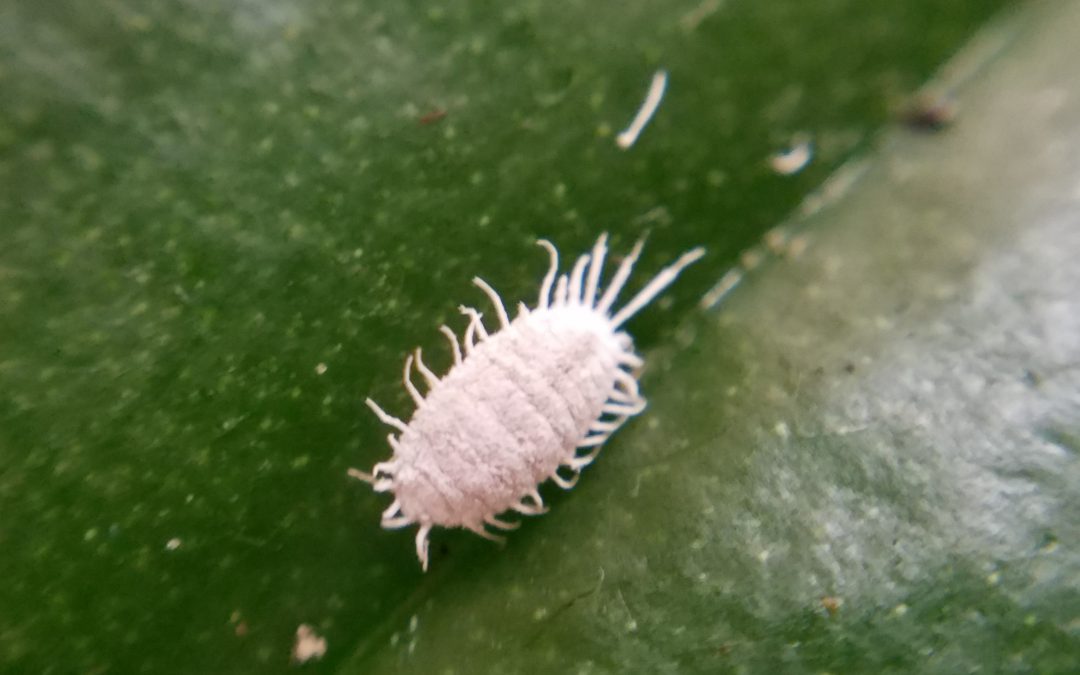
by Evan Anderson | Jun 24, 2021
There are lots of plant pests out there, and it can take a trained eye to tell which one is doing damage. Many of the insect pests that feed on crops and ornamentals have piercing-sucking mouthparts. These insects do not chew on leaves and leave holes behind; instead, they have a long stylus-like mouthpart they use like a straw to suck out plant juices. Over time this can weaken plants, cause irregular growth as damage builds up on new sprouts, introduce diseases to their hosts, and even cause mold to grow on leaves.
Because they drink so much fluid for their meals, many piercing-sucking insects exude a sugary liquid called honeydew. This liquid drops onto stems and leaves below which can leave them shiny and sticky. Eventually, the coating will grow a light greyish coating of sooty mold, which doesn’t do much harm to the plants itself but is a good indicator that you have an insect problem. You may also notice ants on your plants, working to harvest the honeydew for food. The ants don’t harm the plant, but following are some of the pests that do:
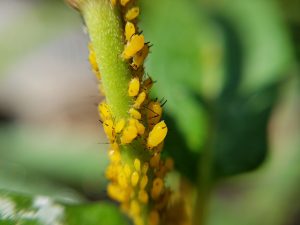
Aphids feeding on a plant stem.
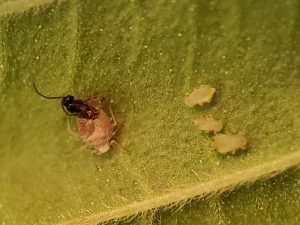
A parasitic wasp emerging from a dead aphid.
Aphids – Found on a wide variety of plants, aphids are fat-bodied little insects that often focus on new, tender growth. Their color depends on the plant they’re feeding on, and they can breed explosively. A female aphid does not need to mate to produce offspring, so a one can produce a lot of children very quickly. Look closely and you might be able to see their cornicles, which look like little tailpipes; these can help identify these pests. Luckily, we have some help in controlling aphids, as they are often parasitized by wasps. If you see large, swollen, brown aphids present, you probably have some wasps working for you.
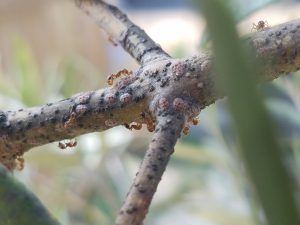
Ants tending some scale insects on a stem.
Scale Insects – Sometimes appearing to just be a bump on a stem or leaf, scale insects don’t move once they pick a plant to live on. Prolific producers of honeydew, some species grow a waxy shell which can protect them and make them difficult to deal with.
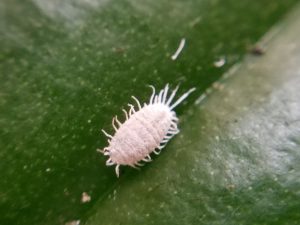
A mealybug.
Mealybugs – If you spy something white and fluffy living on stems or leaves, you might have mealybugs. Soft-bodied insects that are related to scales, they don’t move much. They feed on a wide range of host plants, but can effectively be controlled with a variety of methods once they’re found.
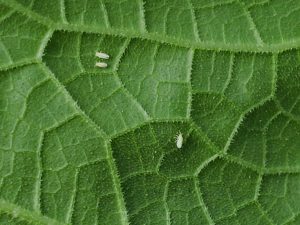
Whiteflies on the underside of a leaf.
Whiteflies – Not true flies, they are truly white in color. Tiny little members of the order Hemiptera (the same order that includes, aphids, scales, and mealybugs), they hang around the undersides of leaves. They enjoy warm weather and can become a problem in greenhouses. They are a bit more difficult to control than some of the other pests listed here.
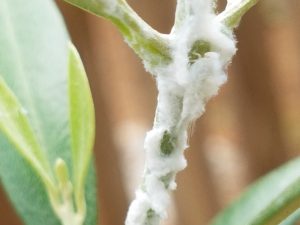
A psyllid nymph hiding in its waxy coating.
Psyllids and planthoppers – Small jumping insects that affect a variety of plant species, some are responsible for transmitting important plant diseases. Pierce’s disease of grapes and citrus greening, for example, are both vectored by these critters. Young nymphs sometimes secrete a waxy coating which may make them look similar to mealybugs.
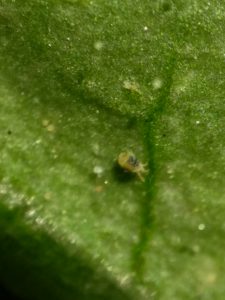
A tiny two-spotted spider mite.
Spider Mites – Not an insect but an arachnid, spider mites love hot, dry weather. Almost microscopic in size, the damage they do to leaves is often the first sign that they are present. Looking closely, one might notice tiny webbing where the mites live, or even the mites themselves on the undersides of leaves and on stems.
Many of these pests can be treated with a combination of methods. A sharp jet of water can dislodge some, hand removal can reduce populations even more, and products such as insecticidal soap or horticultural oils can finish them off. Insecticidal soaps are best used on soft-bodied insects such as aphids or mealybugs, while oils such as neem can help suffocate hard scales. Use products such as horticultural oil in the evening during hot weather to avoid damaging plant tissues with intense sunlight. Thorough coverage is important, as these products only control the pests they contact.
For more information on controlling insects, see our EDIS publications, such as Insect Management in the Home Garden or Landscape Integrated Pest Management.
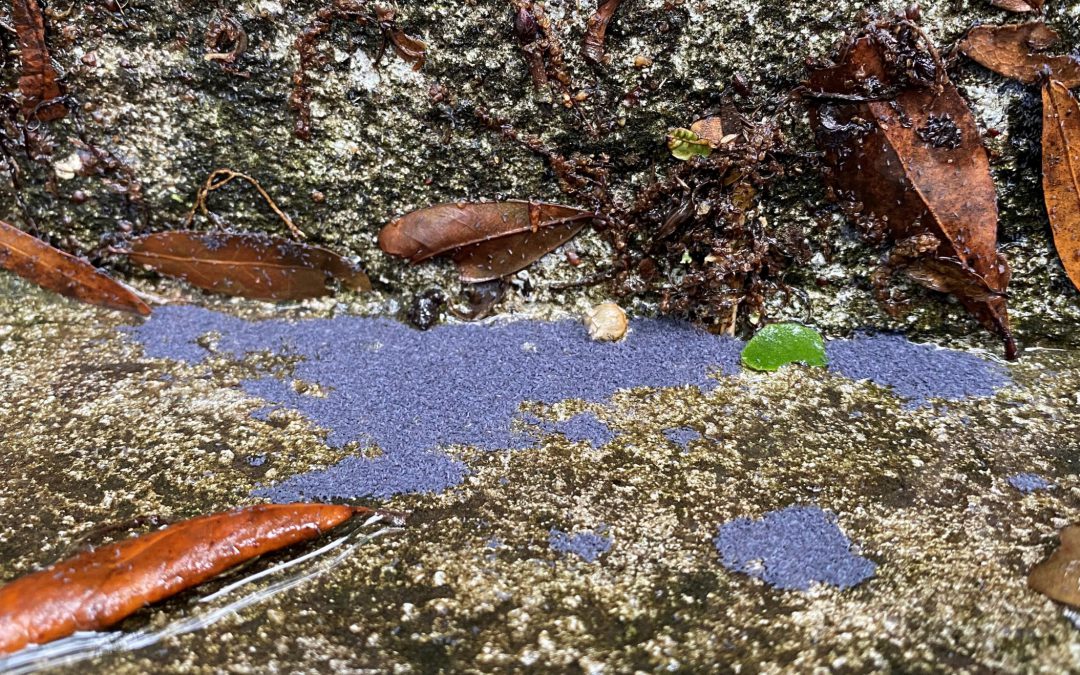
by Matt Lollar | Jun 17, 2021
A month or so ago I was leaving for work and I noticed a strange substance near the entrance to the house. The substance was blue and my first thought was crushed chalk from my kids writing on the sidewalk. Upon closer investigation I realized the substance was moving! It was now clear to me that the substance wasn’t chalk, but a congregation of insects. Naturally, I took pictures and collected a sample to bring into the county extension office…where I work. I looked at the insects under the microscope, but I wasn’t able to determine the species. So I sent some samples off to the University of Florida/IFAS Entomology and Nematology Department and the Florida Department of Agriculture and Consumer Services.
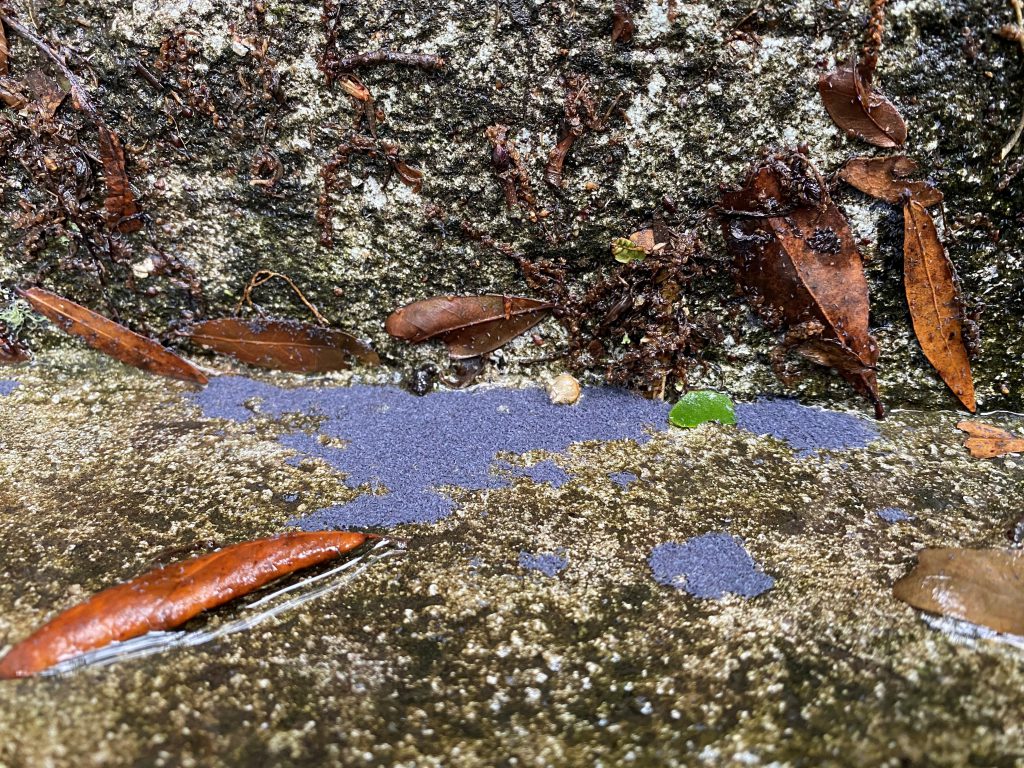
A swarm of Desoria flora on damp, outdoor steps. Photo Credit: Matt Lollar, University of Florida/IFAS Extension – Santa Rosa County
The experts identified the specimens as Desoria flora, a species of springtail insects endemic to Florida and originally described in Alachua County in 1980. Both entomologists thought it was unique the springtails were swarming. Springtails live in leaf litter and upper layers of soils. They are sometimes found in the potting mix of indoor and outdoor plants. Clients bring springtail specimens in to the office for identification from time to time. However, this was the first time I had seen them in a congregation.
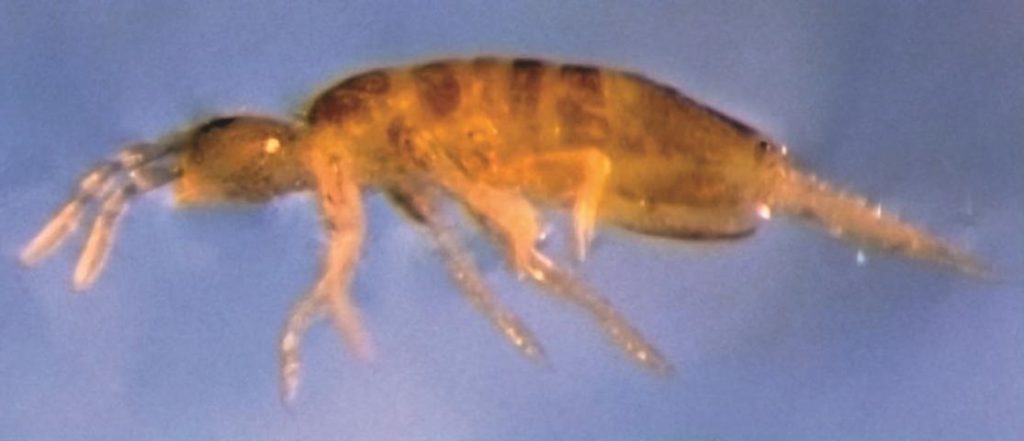
A linear springtail. Photo Credit: University of Florida/IFAS
If you find interesting insects, plants, or fungi and want them identified, please bring them into your local Extension Office. We’d be happy to help you identify the specimens. But sometimes we have to mail things off to a specialist.
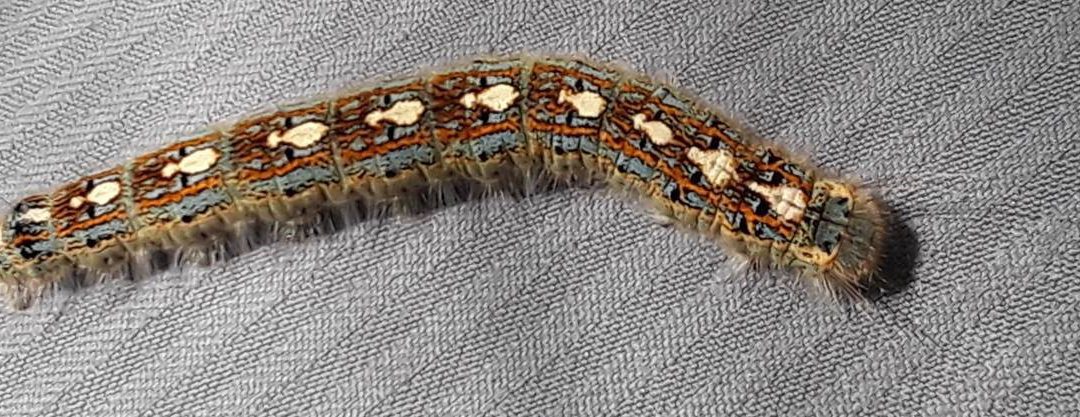
by Evan Anderson | May 20, 2021
A number of landowners in our region have been noticing a number of caterpillars coming down from the treetops. Sometimes appearing in vast numbers, the forest tent caterpillar has been found throughout Florida and the United States. Several years of heavy infestation occurred in Central Florida more than a decade ago, but populations are usually not high enough to cause significant damage to trees.

A forest tent caterpillar. – Photo courtesy of Shoal Sanctuary Nature Preserve.
The forest tent caterpillar is the larval stage of a somewhat nondescript brown moth. The moths lay their egg masses on twigs, and the eggs hatch in the spring. Caterpillars feed on a variety of tree species, but seem to prefer oak and gum trees. They spend anywhere from two to six weeks eating. When they are nearing maturity, they can become a problem for humans who do not appreciate the many droppings they produce, or their habit of descending from the trees to find places to spin their cocoons. They are sometimes attracted to lights or the walls of buildings, where they congregate in search of a place to pupate. They are not harmful to people, however.
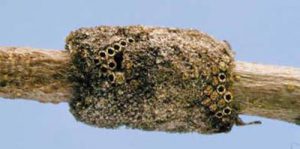
A forest tent caterpillar egg mass. – Photo courtesy of Jeffrey Lotz, Division of Plant Industry
Particularly cold winters may help decrease populations of these caterpillars. Inclement weather or high temperatures may do the same in the summer, and natural predators often help to control populations when present as well. Controlling forest tent caterpillars is most often unnecessary even when there are large numbers of them. It may help to avoid parking cars under large infestations or to turn off outdoor lighting that might attract them at night. If they wander indoors, check screens and window seals to be sure there are no gaps for them to enter.
If these or other caterpillars become such a nuisance that control measures must be considered, consider using a product such as Bacillus thuringiensis, or Bt, which specifically affects caterpillars and not other beneficial insects. Keep affected trees healthy with proper fertilization and watering, and even a defoliated tree will probably recover from any damage these insects cause. For more information, see our EDIS publication on the Forest Tent Caterpillar or contact your local Extension office.
-Evan Anderson, Walton County Horticulture Agent.
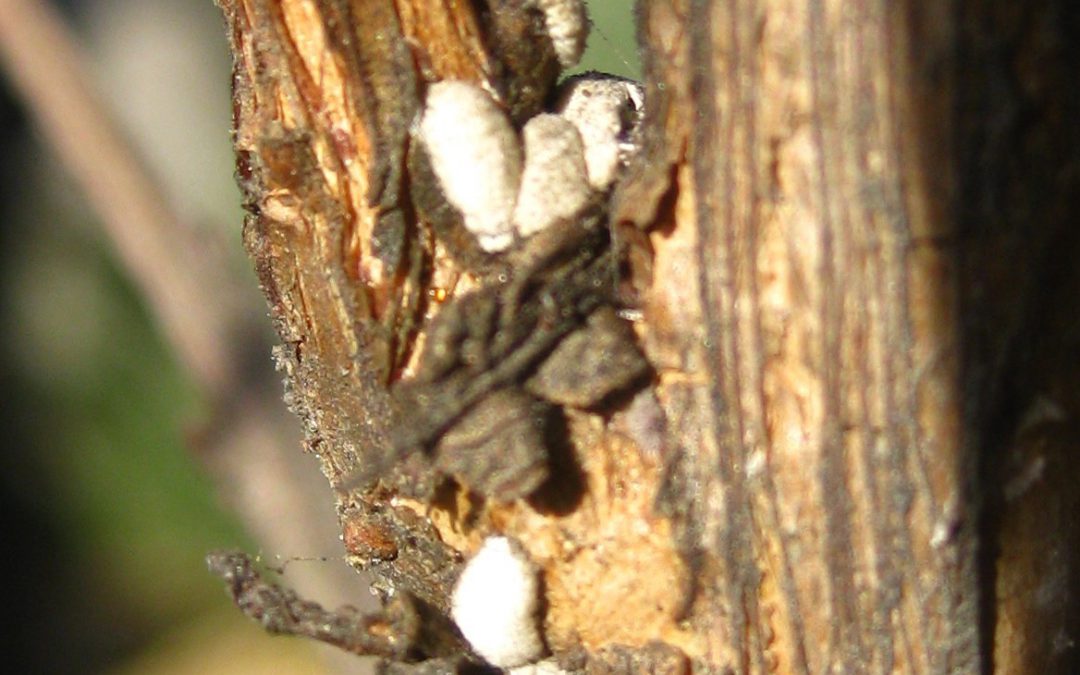
by Mary Salinas | May 6, 2021
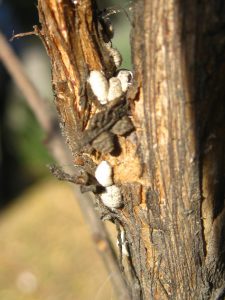
Crapemyrtle bark scale are often found in branch crotches and wounds to the bark. Photo credit: Gary Knox, UF/IFAS.
There is a new pest in the western panhandle of Florida. Crapemyrtle bark scale (CMBS) is a scale that is found on the trunks, branches, and twigs of crapemyrtle. It is the only known scale insect found on the bark of crapemyrtle. There are other scales that occur on the leaves.
When scouting for this pest, look for very small (2 mm or 0.08 inch) white or light gray spots on the bark of crapemyrtle. The adult females do not ever move once they have found a place to feed and reproduce. Under her protective covering, she lays eggs that hatch into ‘crawlers’ that then crawl away to find their own spot to settle down. When squished, they exude a pink goo (the eggs or newly hatched crawlers). Males are winged and travel to find their mates. See this comprehensive information on their interesting biology.
While the scale does not outright kill the trees, it lessens their landscape value and can reduce flowering. And like other scale, CMBS secretes lots of honeydew; black sooty mold then feeds and grows on the honeydew. The black sooty mold does not harm the plants directly, but it is unsightly and can interfere with photosynthesis if present on the leaves.
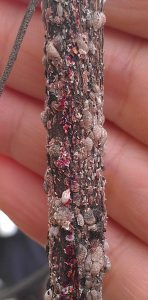
Crapemyrtle bark scale are white to gray and ooze pink when squished. Photo credit: Gary Knox, UF/IFAS. ,
Unfortunately, CMBS has also been found on a very popular native bush, American beautyberry, Callicarpa americana, and it is yet unknown whether CMBS will expand its host range to other plant species in our country. In Asia, this pest has been found on some economically important crops like pomegranate and persimmon.
CMBS is a tough insect to control. And it is best left to the professionals. Dr. Adam Dale, an entomologist at the University of Florida, recommends using pyriproxyfen (in the product Distance) or buprofezin (in the product Talus). These are insect growth regulators that have shown to provide great control of CMBS and other similar scale insects on trees and other woody plants. Although these products are not systemic, they are translaminar, which helps increase their control and reduce any non-target effects on beneficial insects like bees. Two applications 7–14 days apart are suggested. However, these products can only be applied by licensed pest control applicators.
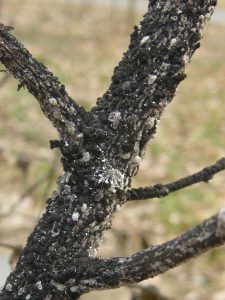
Severe infestation of crapemyrtle bark scale and sooty black mold. Photo credit: Gary Knox, UF/IFAS.
Systemic insecticide drenches are effective but pose a dangerous hazard to bees and other pollinators as the poison also gets into the flower nectar. The product labels prohibit application of these type of products to flowering plants for that very reason.
Routine close inspection of your crapemyrtle trees is critical for CMBS control. Early treatment will help prevent heavy infestations as seen in some of the photographs. When pruning your crapemyrtles, thoroughly clean your tools between plants to prevent any accidental spread.
Prevent this scale from coming into your landscape in the first place. Inspect all new plants you are considering adding to your landscape for any sign of CMBS or other insect or disease presence.
If you have any questions on making the correct identification of CMBS, or any other insect, contact your county extension office.
Lastly, consider reporting the presence of this new scale to enable researchers to track its spread.
For more information:
Stop CMBS Website
UF/IFAS Featured Creatures: crapemyrtle bark scale
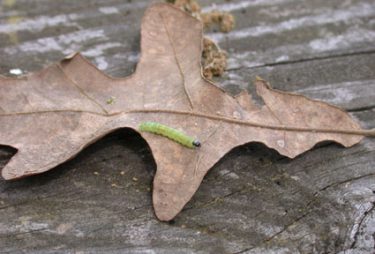
by Matt Lollar | Apr 1, 2021
If you’ve been raking leaves recently, you’ve probably noticed little green worms hanging from the trees. They seem to be in abundance this year and can be found crawling on driveways, just hanging around, and maybe even feeding on oak tree leaves.
These green worms that are all over the yard are oak leafrollers (Archips semiferanus) or oak leaftiers (Croesia semipurpurana). Some people may refer to them as inchworms, however a number of different caterpillars can go by that name. Leafrollers and leaftiers range in length from 1/4″ to 1″. The adult form of these insects is a 1/2″ long moth. The oak leafroller moth is mottled tan and brown and the oak leaftier moth is yellow with brown markings.
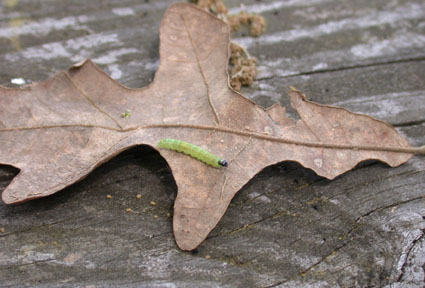
An oak leafroller caterpillar crawling on a leaf. Photo Credit: Blair Fannin, Texas A&M University
In May, the adults of both species lay their eggs in the twigs and leaf buds of a number of tree species. The eggs don’t hatch until March of the following year. When the caterpillars emerge, they feed on the newly forming leaves and flowers of oak, hackberry, pecan and walnut trees. If they are disturbed, they will stop feeding and hang from a strand of silk. Oak leafroller caterpillars pupate in tree branches, while oak leaftier caterpillars drop to the ground and pupate in leaf litter. Adult moths emerge in one to two weeks.
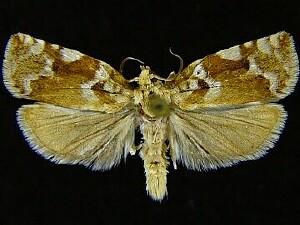
A leafroller moth with wings spread. Photo Credit: U.S. National Museum
The oak leafrollers and oak leaftiers don’t really do enough damage to be considered pests, but they are a bit of a nuisance. Thankfully, birds and parasitic wasps will eat and kill the majority of the population. For in-depth information on most of the interesting insects in your yard, please visit the UF/IFAS Featured Creatures Website.
























